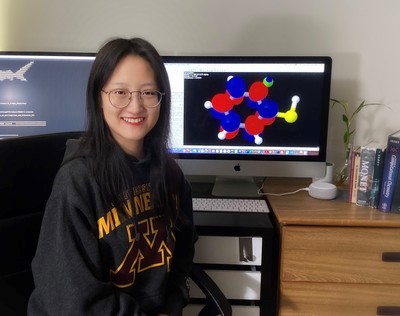Jiaxin Ning has been awarded the 2021 John Overend Award for Graduate Research in Physical Chemistry. Jiaxin was given this award in recognition of her outstanding work on the following two research articles:
“The Valence and Rydberg States of Dienes,” J. Ning and D. G. Truhlar, Physical Chemistry Chemical Physics 22, 6176-6183 (2020). doi.org/10.1039/c9cp06952f
“Spin-Orbit Coupling Changes the Identity of the Hyper-Open-Shell Ground State of Ce+, and the Bond Dissociation Energy of CeH+ Proves to be Challenging for Theory,” J. Ning and D. G. Truhlar, Journal of Chemical Theory and Computation 17, 1421−1434 (2021). doi.org/10.1021/acs.jctc.0c01124
Polychromophoric assemblies are widespread in both biological systems and functional materials, and 1,3-cyclohexadiene and 1,4-cyclohexadiene are classic prototypes for investigating the electronic structures of molecules with interacting conjugated and unconjugated double bonds, respectively. The existence of Rydberg states interspersed with the valence states makes the quantum mechanical calculation of their spectra very challenging and has led to uncertainty about the extent of valence–Rydberg mixing. This paper, for the first time, demonstrates that one can calculate the whole spectrum of valence and Rydberg states in a consistent fashion; the agreement of theory with experiment is remarkable. A special characteristic of Jiaxin’s analysis is the calculation of the second moments of the excited-state orbitals. These moments give a more accurate picture of the diffuseness of the excited-state orbitals in these prototype molecules than had previously been available.
The second paper describes calculations that open new pathways for treating bonds to heavy metals. Because Ce is in the sixth row of the periodic table, relativistic effects must be treated consistently in the molecule and the dissociated ion, and the treatment of Ce+ turned out to require the development of new strategies. Jiaxin found that the ground state is different with and without spin-orbit coupling. She also found that the ground doublet state of Ce+ is an intra-atomic hyper-open-shell state. Out of 40 multireference and single-reference methods tested, only seven get the identity of the spin-orbit-free ground state right. The dissociation energy calculations show that the quantitative chemistry of bonds to sixth-period metal atoms presents a serious challenge to quantitative quantum chemistry.
Jiaxin is currently working on the simulation of the photodissociation of 2-fluorothiophenol. Because of the unique role of the intramolecular hydrogen bond, photodissociation and internal relaxation of this molecule provide a prototype for understanding substituent effects on the important p → σ* pathway that is key to understanding photostability in biological molecules. Jiaxin is developing a unique computational procedure for using the coherent switching with decay of mixing (CSDM) method in the SHARC program to do the dynamics simulations with the XMS-CASPT2 method for the electronic structure input.
Jiaxin came to our group after earning a bachelor's degree in chemistry from Nankai University in Tianjin, China. We look forward to her continuing contributions to theoretical and computational physical chemistry.
